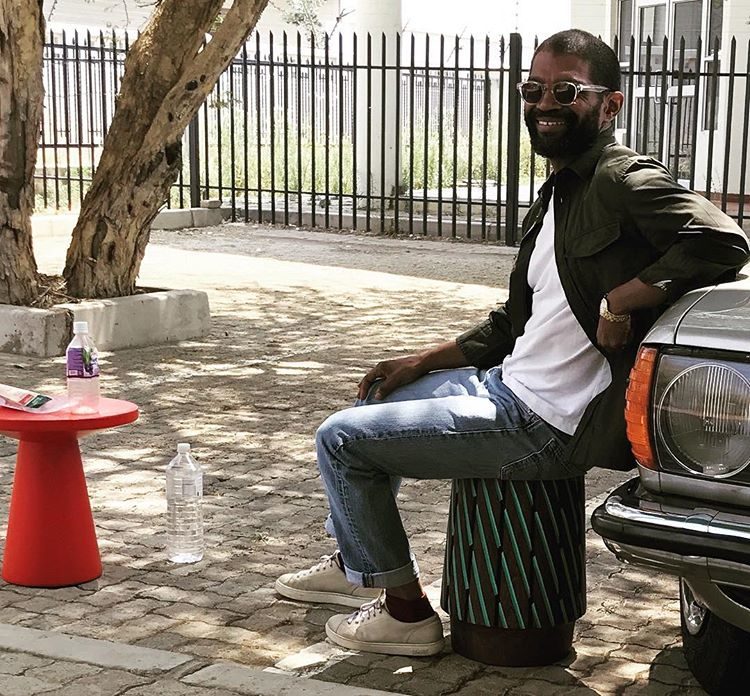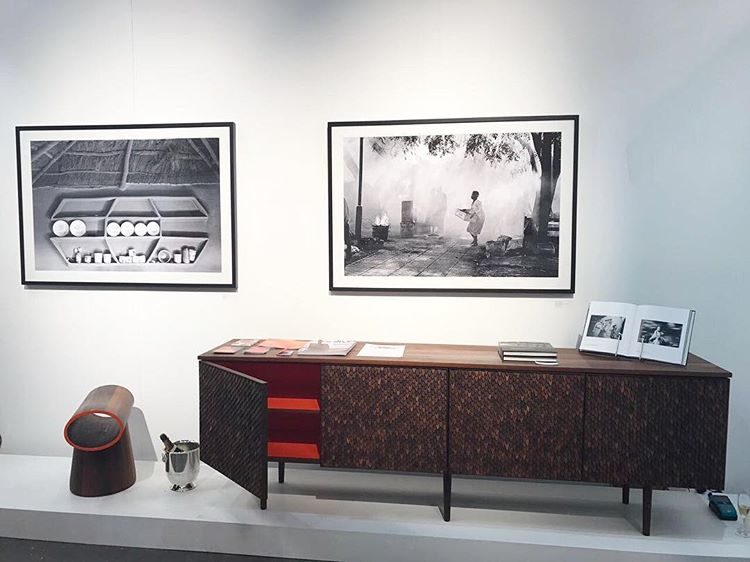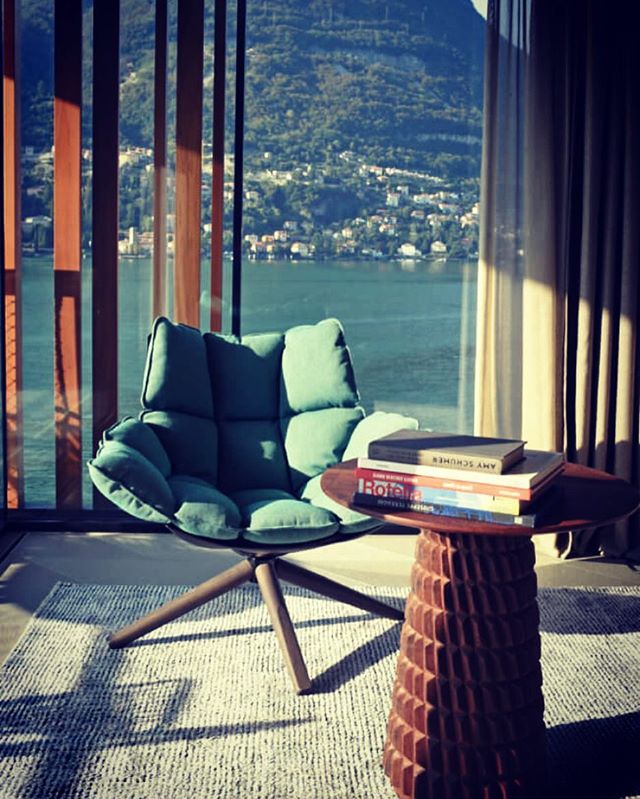After years of making bespoke furniture for commercial customers in Botswana, Peter Mabeo took initial steps towards creating a brand that would be the basis of realizing his aspirations of making interesting products in a meaningful way with a focus on quality, craftsmanship, design, sustainability, culture, and people. One of the most recognized design brands in Africa, Mabeo furniture has ongoing collaborations with some of the most renowned international designers such as Calesson Koivisto Rune, Garth Roberts, Luca Nichetto, Patty Johnson, Patricia Urquiola, and Studio Noi. Peter talks about African contemporary culture, sustainability, and his holistic approach the design.
How did you get inspired to start Mabeo? And how would you describe the brand?
It was a series of events I guess, combined with watching things that did not make total sense, mixed up with my interests. After trying dismally to make objects that were just based on aspiration, in an attempt to be worldly without any consideration, I just went for it. The push in our part of the world is to be worldly, to show that one has the latest products and lifestyle that personify success. Doing this without question has us trailing to catch up with the world. Even when we think about creativity it is the same process or approach. I could not do this without factoring in some level of questioning or critical thinking in the process.
So I decided to actively investigate what could be possible, and starting Mabeo seemed logical as it could allow for there to be a formalized and systematic way of realizing objects that expressed the interest in simplicity, African contemporary culture, purity of materials, equal collaborations, sustainability, a holistic approach in general. The idea of success in Africa, Forbes lists, macro economic indicators, or being cool, in isolation to the detrimental direction that we take is boring and uninspiring to me. Creating a brand that has the capacity to have its core activity, and not some trivial social responsibility project, working in harmony and respectfully with what is being excluded – the vast majority of people and their culture, seemed logical and exciting to me. It’s very difficult as it questions the core of what most successful players in Africa define themselves with, either net worth, or charity organizations, etc., but it is rewarding none the less.
There’s not a lot of African influence in contemporary design at the moment. How do see that changing and evolving? How is Mabeo contributing?
First, colonialists use African culture for feeding an insatiable appetite for consuming exoticism. Then western artists and designers were inspired by African craft. Today, there is a lot of promotional activity around African design. While this is very positive in many ways, I still see extraction and appropriation going on. When the lead players are external, like the curators and western designers who traverse the continent searching for talent in Africa do sometimes, this cannot be avoided I guess. There are many well-intentioned initiatives and projects. This I am sure of. However, there is an elitist approach to this, and the vast majority of craftspeople either play a role that provides the authenticity ingredient or benefits directly from the project. But this tends to be temporary and is left behind once the project is finished. It could be a way towards more significant activities, I do not know.
Beyond the trendy use of African culture as a way of being cool, there is also the idea of design being used to as a tool to assist the so called marginalized and the poor. There is paternalistic feeling about this that also helps to propel promotional efforts. Perhaps our work is this way too. I wonder about it and it is part of what I like to consider as we carry on. So maybe instead of contributing to the African influence, if Mabeo is to contribute, then it could be by considering these seemingly complex issues as we work. This has to be done simply and easily. It has to start from the minute actions and from the relationships.
Mabeo is one of the most recognized African brands. What do you attribute that to?
Maybe in actuality, we were just first off the gates (laughter). Maybe it is our relationship with great designers from across the world. I cannot say it definitively. But it may have something to do with the inability to compromise on quality, on consistently navigating the divided world of craft and the local environment on the one side and international commerce on the other. It is very complicated and it may not make immediate sense. It has taken over 20 years of combining what some may call intuition with conforming to the strictures of commerce, with enormous sacrifice by all those involved. But maybe there is something to be said about beauty realized under trying conditions. There is a freshness that comes with this I guess; the kind of freshness that people pay enormous amounts for. It is not about being innovative or smart, but more based on viewing all things, especially people, equally and basing our work on this.
How are you interacting with the young creative scene in Africa and the Diaspora?
All our work is primarily based on the artisans and craftspeople we work with. Some have the title of employees while others work under the structures of cooperative, or a community projects (a label that has negative connotations). With all of these artisans and craftspeople, without exception, they are all senior people. Young people, and this is the case throughout the continent I imagine, are simply not interested in craft related activity. Either because it has remained static and undervalued by colonially-minded tourism activities that render craft activity as exotic or petty safari souvenirs, etc. which still prevails today; or because technology, music videos, Instagram fame, etc. just have much more appeal.
Our interaction with young people has been to show that what the previous generations of crafts people have in Africa is something that is quite incredible. It is the city kids, who are often educated, and those who previously shunned culture in Africa, who are at the forefront of appropriating culture. It’s because they are exposed much more to popular culture, Black Panther, AfroPunk, etc. They are now starting to see value in Africanness, or the idea of it at least. When interacting with young people, who often lie outside of the creative scene in villages and craft-rich pockets in the city, I let them know how important it is for them to carry on the techniques and the culture of making as they carry this heritage within themselves, about how those who have had the privilege of going to private schools have lost this, and to look at how they are posing on Instagram, expressing an idea of something that they have possessed this throughout their lives. I encourage them to not care for the flashy life, as they are authentically cool. So my interest is not to feed the creative scene or to create one. I am interested in removing the cloak division has created in society by signing back an atmosphere of respect that allows those who are the custodians of the ingredients that are used for creativity in Africa can simply do what they do. This is where creativity, the kind that can alter educational programs and to contribute to the world instead of trying to measure up to it resides. I am also working with young designers and architects who have graduated from the University of Botswana. I tell them about this. But I also have them interacting with some of the best international design and architectural studios. The idea is to re-establish the confidence that has been lost by understanding the universal nature of craft, and how we have an important contribution to make. Not to try to build ourselves up as personalities who stand out and apart from our neglected societies, but show the incredible value and richness that exists.
In the Diaspora, working with young people who could find our approach interesting, and providing a way for young people, regardless of social status, whether first world or third world, rural or urban, to interact equally using design, craft and to engage in cultural exchange, the kind that really matters and impacts everyday living, economically, socially, practically.
What’s your design environment like?
It is not fixed. It is based on historical and current references that there is an appreciation for. It is open and exploratory. It is inclusive – involving the contribution of the African crafts person and the designer in equal measure. It is an environment where there is understanding that current activities may be criticized in the future and trends are not to be taken too seriously. It is also an environment of conflicting principles. Where the issue of practicality and idealism often clash. At the time of the height of this kind of conflict, there is strife. But with patience, this turns into something interesting. So while it is challenging, it is also very interesting.
What makes great design?
The fact that it cannot be described verbally I guess. It is something that everyone, who is able to remove commercial conditioning when observing, can see immediately. It is simple, universal, and it does not express status. Instead, it’s a demonstration of great care, sensitivity, and deep expression. It is a small window into the mind of a person or group of people at a particular point in time; a window that that shows a timelessness, of humanity engaging in simple acts of living and interaction. But descriptions only capture a small idea of what it is.
How would you describe Mabeo’s approach to identity as its reflected in design?
Identity is not something that should be preconceived for effective communication or for standing apart from the rest. The way we work, live, the issues we deal with, influences, inform how we work. How we work over time has created an identity. It may change, but the essential nature of the way we think, what I have heard as being described as brand DNA will stay the same I imagine. The expression of what is of interest I think is communicated through the work. With this, we have been able to identify others in the different fields of identity related activity that have been responsive and drawn to us. It is really quite simple. It is very exciting when someone who is master in their craft, who we have just met, is able to read what we do with no explanation. Maybe a handful of your readers will read what I am saying and not be surprised after seeing the work somehow. If that is the case, then identity is merely a respectful expression of what already exists.
What is your approach to sustainability?
I understand that every activity on this earth is potentially destructive. I also realize that there will be sustainable methods of working today that will reveal themselves as being destructive in the future. The interest therefore is to approach people who express through everything they do, an acknowledgment of the tension that exists in the various aspects of their work and in general. There is always a sense of hesitation and restraint that is evident. It is individuals such as these who are open to anything that has less and less impact in everything they do, such as regulation (licensing, certifications, and so forth) on its own, without this important trait of being sensitive, enough. Sustainability, like the current interest in African design and culture, is being trivialized to some extent. The real importance is in the mentality that is present as we go through different trends. If the mentality is that of getting ahead, and using this as a promotional identity tool, then it is not significant.
What is your guiding force?
I am not sure. I do understand that I am interested in the possibility of life being less divisive in all respects though.




